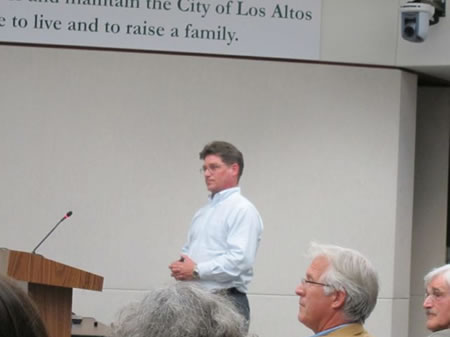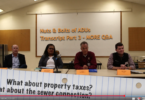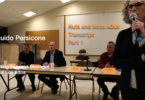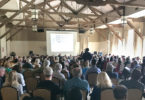Are you a commercial building developer? The Los Altos Planning Commission at its January 19 meeting seemed to suggest that $40,000 is the price for buying out of parking space “deficits” for large office developments downtown. This “price” was established by the “comp” of the new Packard Foundation Building, which bought out a deficit of 84 spaces for $3.4 million over 3 years. However, according to staff discussion at the meeting, the approved (but still unbuilt) Safeway project may have been valued at $6,000 per deficit space. (not quite a comp because of the new shared parking agreement).
I. THE STAFF REPORT
Mr. David Kornfield, Planning Staff, spoke for 45 minutes to the Los Altos Planning Commission. To summarize, he found that the plan for 40 Main Street has a deficit of 28 spaces, exceeds the 30 foot ceiling limit by 5 feet, and has some incursion into the 2 foot back line. He noted that Plaza 10 behind the site (next to the Wells Fargo building) is the most impacted lot downtown with an 85% occupancy. He praised the plan’s pedestrian paseo, and thought that the 35 feet ceiling was not too high. He said he thought a solution to the parking deficit would be to reduce the scale (square footage) of the building. He said the public benefit of the paseo was not equal to the social cost of 28 missing parking spaces.
II. THE APPLICANT PRESENTATION
Mr. Sorensen, the “applicant,” was allowed to speak for 45 minutes, even though initially the Los Altos Planning Commission Chair John Baer told him to keep his remarks to 15 or at most 30 minutes. Mr Sorensen said that when project planning began in 2010, staff had given him “direction” that the plan had a deficit of 5 spaces, and staff thought the deficit could be compensated for with the public pedestrian paseo.
Mr. Sorensen claimed that during each subsequent meeting with the city, the deficit kept rising to 15, 28 or even 40+ stalls.
He said he followed the common practice of large developments (like the downtown Safeway, like the Packard Foundation Building) to contract for their own private traffic study. Based on that study the applicant argued for a parking ratio of 2.0 to 2.6 per 1000 square feet, rather than official zoning code of 3.3.
III. THE QUESTIONS TO STAFF AND APPLICANT
During the Commissioners’ questioning of Kornfield and Sorensen, several interesting points were mentioned. All the city owned parking plazas were all once privately owned by the Main and State Street property owners. But during the 1950’s, the Nelson, Kahn, and Cranston families started a movement to transfer the lots to the city to maintain and use as parking in common for all property owners. Recently the city has implemented some basic modern traffic management measures — restriping stalls to be smaller, a “white dot” system of all day parking in more remote areas for employees.
However, Plaza 10 (behind Wells Fargo’s lot and the 40 Main Street buildings) has 57% white dot stalls.
The next most dense long-term lot is at 15% white dots. An unusually high proportion of white dots were assigned to Plaza 10 because of the existing office building at 4 Main street which houses the legal offices of the Packards, some psychology professionals, and other non-retail tenants.
IV. 9:30 PM — THE PUBLIC COMMENTS
The Los Altos Planning Commission took public comment from about 9:30 to 10:30 pm. By my count there were 13 speaking for approving the project and 13 speaking against it.
The 13 speakers favoring the proposal liked the design, the pedestrian paseo, the “vibrancy” it would bring, the way it would be one of the “gateway” buildings. Some speakers said the city needed to improve its management of the shared parking — the burden was the city’s not the developer’s. Several of the pro commenters were commercial real estate brokers who spoke for rapidly increasing the amount of “Class A” office space downtown.
They said Class A office space was the best way to increase “daytime population.”
This is the number that prospective tenant merchants always ask about when choosing a location for their business. The problem with nail and hair salons is that their employees do not have the income to spend on restaurants and shops on Main and State. On the other hand, employees of Class A building will be high-income professionals like venture capitalists “with money in their pocket.” All pro commenters liked the design. Each of the pro speakers mentioned that they almost never had trouble finding a parking space downtown, no matter the time of day.
The 13 speakers opposing the proposed building said they did have trouble finding “appropriate” parking downtown, and, in such cases, would just leave and go to some other destination. A number of con commenters were residents who lived ultra-close, either downtown or just across Edith Ave. They feared the increased menace of traffic on their dirt-curbed streets. Some of these speakers disliked big buildings. Not surprisingly, they disliked this one too. They feared they would lose their views of the hills. The property manager of 4 Main Street asked why the paseo was no longer planned to be next to his building and was now to be next to the Christian Science Read Room. A tenant of the second floor of 4 main street said he would lose his customers if the blank wall of 40 Main’s third floor was built across from his office windows.
“No one sees a shrink who doesn’t have a therapy room with a window.”
V. 10:30 PM – 1:30 AM–THE LOS ALTOS PLANNING COMMISSION DISCUSSION
After hearing all the public comments, the Los Altos Planning Commission called for a short break, and resumed the meeting at 10:30pm. It took them from 10:30 to 1:30 am to get a majority to agree on anything. As you may know, after hearing all the information from staff, the applicant, and the public commenters, the commission discussion starts with each member speaking his/her mind for about 5 minutes. This lets other members know where they stand. The architect on the commission started the process. She praised the design, enjoyed the tower architectural element, but suggested the third floor be set back from the front somewhat to reduce the feeling of mass. She though this might also reduce the parking deficit some. She felt that as a development incentive the parking deficit could be reduced to 10 stalls. The next 5 commissioners were also fairly encouraging but a couple thought the parking deficit was more like 20+ stalls. One commissioner chided a public commenter for comments that could be construed as disrespectful to city staff. That public commenter, an architect, had left during the break along with maybe 20 other people.
But when the chair, Mr. Baer, had his say, it was clear he was very,very far apart from most of the commissioner sentiment. Some of the things he suggested were requiring underground parking, reducing the 3rd floor area by 50%, and removing the tower which he found unattractive, and putting windows on the north side across from the windows of 4 Main Street. He tried to make a motion that no one would second. These folks wrangled about the size of the parking deficit, but finally could agree on 15.
Chair Baer really pushed repetitively again and again on wanting a numerical 50% reduction of the third floor…
… on the need to protect the value of the existing neighboring 4 Main Street property, how requiring underground parking would increase the value of the 40 Main street project, on how the parking deficit was more like 20+. Several commissioners stated they did definitely want to see the project move forward to increase downtown vibrancy.
By around midnight, the audience, now about 30 persons, was definitely was giving up and leaving. At about a quarter to 1am, commissioners were getting cross and very motivated to wrap this up. Yet key commissioners stood their ground. One said to Baer that repeating an issue again and again to see if commissioners would change their sentiment was useless.
This commissioner said the language of the motions should tell the applicant what to do, but not how to do it–the architect needed flexibility.
When the motions finally were passed around 1:30 am, the size of the audience was down to about 15 persons.
VI. THE MOTIONS ROUGHLY PARAPHRASED
Here I will paraphrase the gist of the language of the motions as best I can:
1. Reduce the 3rd floor consistent with providing setback…. ( No, numerical requirement)
Passed 5 to 2. Mike & Jeannie Nay.
2. Developer to address the parking deficit of 15 stalls ( as determined by zoning code of 3. 3 spaces per 1000 sq feet) by any means approved by staff. Passed 7-0
3. Developer to work with 4 Main Street owners to integrate the two buildings facades and enhance the architectural relationship between the buildings. Passed 5-2.
4. Allow the height variance of 35 ft to give the developer flexibility as they develop an entryway location to downtown. (vote unknown)
It is not unusual for a commission or city council to rely on staff and the city attorney to craft the final language.
WHAT DOES IT MEAN? – SAVING OVER $500K
It means the developer may save over $500,0000 on any potential parking buy-out (in-lieu) agreement with the city, if that is the route the Sorensens would prefer to pursue. The developer and architects still have flexibility to go in other directions, such as designing a smaller building.
However, the Planning Commission recommendations now go to Los Altos City Council where they could all be accepted, modified, or totally overturned.
EDITORIAL COMMENT:
BROWN ACT CONCERNS–MORE BERKELEY SUNSHINE
The Planning Commission does comply with Brown and post its Agenda online and probably in the Library and City offices for view 4 days ahead of the meeting. That’s fine. Unfortunately, unlike is done for the Los Altos City Council, the Planning Commission agenda packet is not posted online 4 days ahead. Rather it is placed in a binder in the Council Chambers anteroom some hours before the meeting. That meets the low bar of the Brown Act, but this is useless for modern adults. What can you learn when one is seeing a single copy of a 40-page and up document for the first time.
When a meeting goes past 11 pm as this one did, that is just inhumane.
The City of Los Altos has mimicked Berkeley in its current website design, but we think it’s time to also mimic Berkeley with it’s 2010 Sunshine Ordinance. Berkeley meeting rules now require the Council and Commissions to make a plan at 10:30 pm for wrapping up by 11:30pm or to just continue everything. It requires online availability of agenda packets for the major commissions. It allows public commenters to give their 2-3 minute slot to another speaker, with limits. It requires the city to make projection equipment available to public commenters, not just to the applicants and staff.
The City Council of Los Altos has been making videos of its meeting available for delayed streaming online to PCs for a few years now. Los Altos Politico believes video service should be extended to the Planning, Architecture & Site, and Traffic Commission. We notice that Berkeley makes the video stream available in formats like MP3 and MP4 which can be used on a mobile device. The current city service requires a PC or Mac to view the stream. It would be great if citizens could take a look at snippets of the proceeding from their mobile.
Such changes would be a tremendous improvement to the transparency of the more powerful commissions like Planning, Architecture & Site, and Traffic
… if Traffic does not get folded into Planning later this year. We are NOT recommending that Los Altos imitate the part of the ordinance where Berkeley now posts its agenda and agenda packet 11 days in advance of meeting!
EDITORIAL COMMENT: 1st AMENDMENT PHOTOSHOPPED
The anteroom of the Los Altos City Council is a public place, so we suppose it is not illegal for a person to drop off their own non-commercial flyers. Someone prepared an 8-page color flyer, where the 40 Main project was photoshopped into photos of the site, with scale distortions that made the project “unattractive.” The Architect of the project politely critiqued distorted artwork of the flyer which was masquerading as “offical” She showed the real street level and pedestrian level renderings. Very different. Litter or proper exercise of 1st amendment rights?













